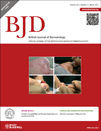Acquired bilateral melanosis of the neck in perimenopausal women
Funding sources This work was supported by grants from the Korean Health Technology R&D project, Ministry for Health, Welfare and Family Affairs, Republic of Korea (A100179) and the Korean Science and Engineering Foundation (KOSEF) grant funded by the Korean government (MOST) (R13-2003-019).
Conflicts of interest None declared.
Summary
Background Acquired bilateral patchy or mottled pigmentation of the neck has occasionally been observed.
Objective To investigate the clinical and histopathological characteristics of this pigmentation.
Methods Fourteen patients were included in the study. Patch and photopatch tests, and laboratory tests including serum hormonal evaluation were performed. Skin biopsies were performed on lesional skin and perilesional normal skin.
Results All the patients were women and all were perimenopausal. The lesions were characterized by bilateral, symmetrical, brown-to-grey patchy or mottled pigmentation on the lateral neck. There were positive photopatch results in some cases, but their relevance was doubtful. All laboratory findings were within the normal ranges. The histological findings showed marked accumulation of pigment in the dermis with perivascular lymphocytic infiltration. A significantly higher expression of melanogenesis-associated proteins and an increased number of melanocytes were observed in the epidermis of the lesional skin. The melanin-bearing cells in the dermis were stained with factor XIIIa or CD68, but the majority of these cells were identified as factor XIIIa+ dermal dendrocytes. Some brown pigments were mixed with light brown or golden brown pigment that was positive in iron staining.
Conclusions These cases seem to represent a continuum of Riehl melanosis. However, the principal distribution of the pigmentation is a distinguishing feature. Any consistent predisposing factors were not established, but there may be a role for subclinical injury or inflammation as possible causative factors for development of the pigmentation.




